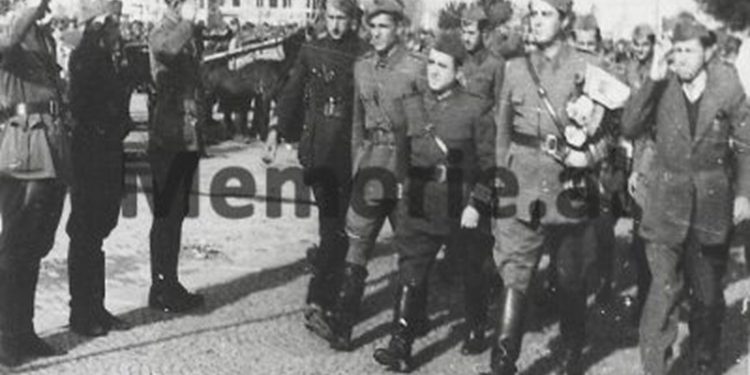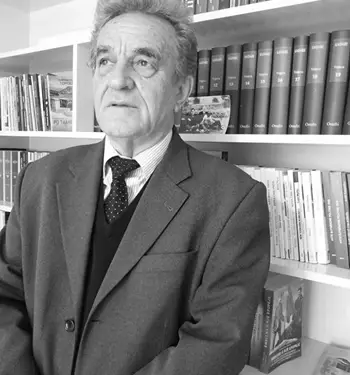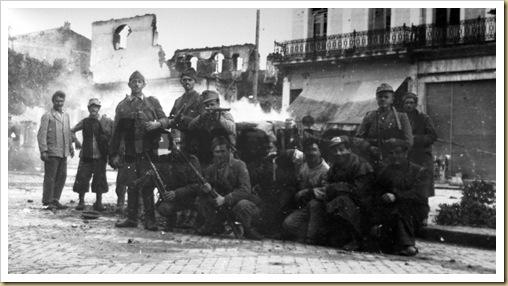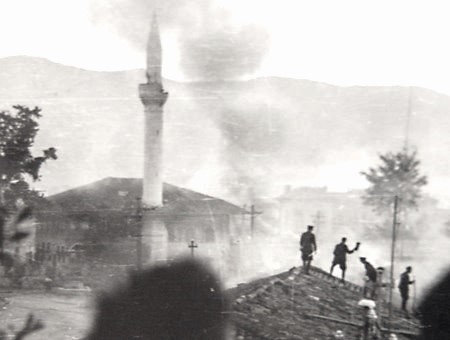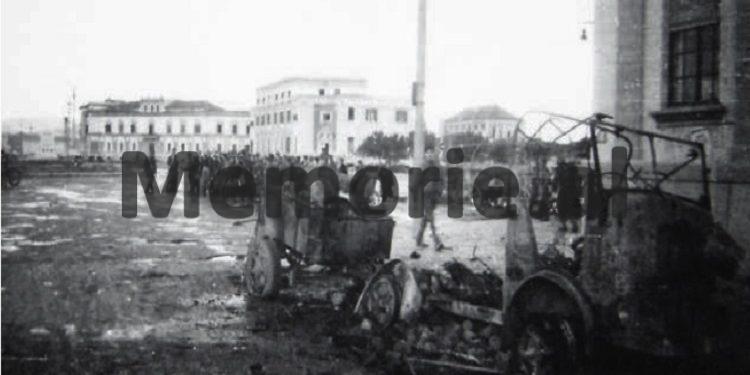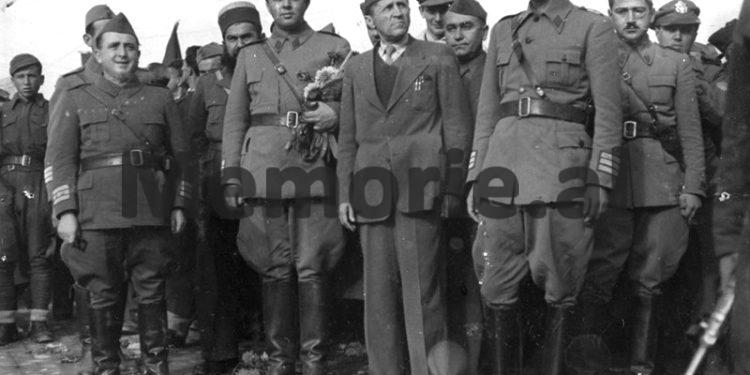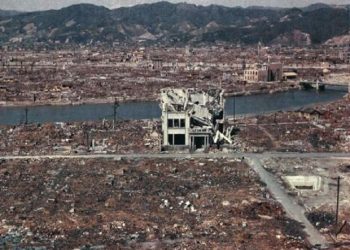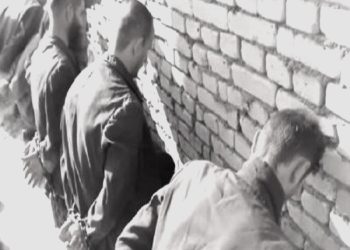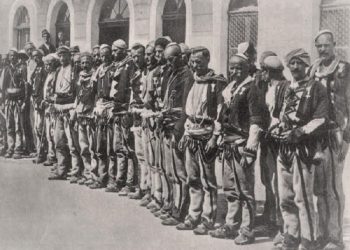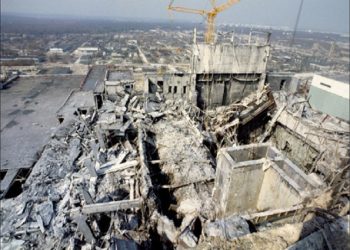From DR. URAN BUTKA
Memorie.al / Alongside the war for the liberation of Tirana from the Nazi invaders, the communist forces ordered by terrorist leaders such as Enver Hoxha, Dali Ndreu, Mehmet Shehu, Kristo Themelko, etc., also carried out massacres against patriotic and democratic intellectuals, political opponents, and even innocent civilians. According to the strategy of the CPA (Communist Party of Albania) and the special scenario for Tirana, the day of liberation had to find Albania, and especially the capital, without those nationalists and pro-Western intellectuals, without the well-known figures of Albanian culture and education, without those patriotic officers who did not join the Front, honest officials, without the owners, merchants, and businessmen who sustained the market economy of the Albanian state, without those patriots and democrats who had fought and aspired for an independent, united, and democratic Albania!
Everything was projected by the chief terrorist Enver Hoxha. “When I talked to Enver,” Kristo Themelko affirmed, “he advised me that when we entered the city, we should cleanse the dangerous elements. Therefore, when I entered Tirana, I requested a list from the organization for these elements, to clean them out during the war.”
The secretary of the Communist Party’s District Committee of Tirana, Gogo Nushi, confirms the massacres in his own words in his reports addressed to Enver Hoxha: “We have seen this terrorist spirit in Tirana in recent days. This shows our line. With the entry of our forces, 60 people were killed. We have the list. I think none of them deserved this punishment. We are sure we will have others too. The number will have exceeded 100.” “We discussed with Mehmet that we should eliminate those reactionary elements,” testified Nako Spiru.
Thus, we are dealing with a politically motivated genocide. In Tirana, well-known figures from all over Albania, from Kosovo, Dibra e Madhe, and Chameria, and even foreign nationals, were killed without trial and without fault, treacherously and at midnight, in groups or one by one from behind, even on the doorsteps of houses, at street corners, on the riverbank, in Sharrë, Priskë, and Sauk, without giving any explanation, leaving no trace, and even leaving them without a grave. All of this was done so that terror and fear would be felt everywhere and spread in circles from Tirana to all Albanian lands.
Because they would take and hold power through terror and blood, because only in this way could the most unparalleled and bloodiest dictatorship in all the communist Eastern countries be established and function—the dictatorship of Enver Hoxha.
The first political murder was that of the prominent Tirana cleric, Selim Brahja, on August 31, 1943. They killed him outside the door of God’s house, on the threshold of the Mosque. Seven men from the Peza punitive unit, with red scarves on their heads, shot him several times and vanished to escape the shots from Selim Brahja’s house. This murder marks the beginning of communist terror in Tirana.
Why did they kill this man who had dedicated his life to God and Albania?! He came from a patriotic family. His father, Ramazan Brahja, participated in the raising of the flag on November 26, 1912, in Tirana. Selim Brahja, an intellectual, a theology graduate from Istanbul, was devoted to faith and Albanianism. He opened the first Albanian school in Sauk. During the Italian occupation, he was imprisoned by the fascists because he hosted both nationalists and partisans fighting for freedom in his home. He participated in the Mukje Conference along with Ismail Agë Petrela, Dr. Nroçi, and other Tirana nationalists.
That is why the terrorists with a star and a red scarf on their heads killed him. On October 29, 1943, the Peza punitive unit barbarically massacred Besnik Çano (22 years old) and Qeramedin Sulo (21 years old), two young nationalist intellectuals, participants in the Mukje Conference who were traveling to Southern Albania to convey the message of this national agreement.
Also in October of that year, Mehmet Shehu executed without trial in Priskë, 13 gendarmes who surrendered in good faith to the First Brigade, including: Preng Marku from Kaçinara, Zef Ndoc Simoni from Fishta, Preng Lek Shkreli from Malësia of Shkodra, Pjetër Shkalleshi from Kthella, and corporal Ali Maksuti from Margëlliç of Chameria, a well-known florist in Tirana.
Later, they also killed Professor-Doctor Lorenc Rasha, from Shkodra, a man of knowledge. He completed high school and university in Austria with excellent results and held a doctorate in linguistics. This renowned intellectual and nationalist were executed without trial on September 12, 1944, by the firing squad of the “Dajti” partisan battalion, on the edge of the Priska stream. Following these murders in the periphery, it was the turn of the capital.
And the communist terrorists chose the most favorable time to carry out the massacres in Tirana. The liberation of Tirana was considered by the communist leaders as the seizure of power. “Whoever takes the capital, takes power,” Enver Hoxha instructed.
The curtain of this tragedy opened on the night of October 28, 1944, when communist guerilla units and forces of the Discipline Battalion secretly entered Tirana houses at night like hyenas, arresting or executing Albanians who had been marked on the death lists by their leaders.
Thus, they appeared at midnight at the house of Ymer Dërhemi and arrested Akil Sakiqi, Nazmi Uruçi, and Fahri Dabulla. “You are wanted for a clarification.” But they were executed that same night. Akil Sakiqi was from Dibra e Madhe. His patriotic family, pursued by the Serbo-Macedonian genocide, immigrated to Turkey, then settled in Tirana. After finishing the Korça Lyceum, Akili completed the Military Academy in Rome, the Finance Guard branch. He served devotedly in Durrës, Shkodër, etc., always in the rear. On April 7, 1939, he fought alongside Myftar Jegeni and many other officers of the National Army against the Italian aggression.
Nazmi Uruçi was also from Dibra e Madhe, from a patriotic family. Fahri Dabulla was from Gjirokastra. Adili, Nazmiu, and Fahriu, all three well-known career officers, ardent patriots, honest and unblemished Albanians, had completed the Korça Lyceum together with E. Hoxha. The terrorist Enver Hoxha put his lyceum friends on the death lists.
The night of October 28, 1944, was designated by the Communist Party’s District Committee for Tirana as the night of mass killings of career military personnel. That night, the following were executed: Hamit Greblleshi, from an indigenous Tirana family, a teacher and later, after graduating from the military Academy in Istanbul, a gendarmerie officer of the Albanian state until 1939, when he retired for health reasons.
Hamit Greblleshi was arrested along with the other officers living on “Tabakëve” Street: Hasan Dinen from Maqellara of Peshkopia, with military academy completed in Italy, a patriot son of a patriot; Azis Blloshmin from the well-known Blloshmi family of Bërzeshta, who had completed military studies in Vienna; Faik Shkupin, an Albanian from Skopje, a military graduate in Italy and serving in Albania; Mehmet Dado and Boris Belevskin, a White Russian, an officer in the Albanian army; Aleks Mavraqi, Selmam Shtjefni, Bajram Cuka, and others whose graves are not even known.
One of those dozens who disappeared is Major Muharrem Liku, a devoted son of Tirana, a military officer of the Albanian state who served the homeland and the King faithfully. That is why he was put on the death lists. On November 1, 1944, at 3 o’clock in the morning, they knocked on the door of the house. The murderers were looking for Muharrem. He left the house because he felt innocent. At the gate, he saw armed men and another officer of the National Army, Abdulla Saraçi, who had studied in Europe, arrested. They escorted the two of them somewhere, perhaps nowhere.
Only a few minutes passed on the road when the automatic rifle cracked. First Abdulla fell, then bullets pierced Muharrem. They put the corpses in an ice cream cart. The few passers-by saw a cart at dawn from which a bloody hand was hanging. Then two other hands. So, there were two corpses. The family members found them, retrieved their mutilated bodies, and buried them at Bami’s Grave. One finger of Abdulla’s hand was cut off along with the gold ring.
That same night, the communist terrorists arrested and killed the military officer with the rank of Captain, Anton Fekeçi, born in Graz, Austria, but residing and serving in Albania, because his mother, Gjystina, was from Shkodra, from the renowned Bumçi family. Antoni was a model officer with a Western formation and highly professionally capable. At midnight on October 30, they called him home and executed him 100 meters away. Then they returned, forced the family into the street, because they needed the house, just as they needed the furniture, the typewriter, etc.
The tragedy of this family ended with the death in prison of Frederik, Anton’s son, convicted for agitation and propaganda, like thousands of other children of these martyrs. On November 3, 1944, communist forces executed without trial in Sharrë of Tirana, three prominent Deliallis from Shijak: Kapllan Deliallisi, deputy of Shijak in the Albanian parliament, and his brother, Jakup Deliallisi, former head of the municipality of Shënavlash and Luz. Together with them, Shefqet Deliallisi was also executed, a young officer, a graduate of the Military Academy in Rome, but who received the fascist occupation with indignation and self-departed from duty, because he was against the invaders. Along with these martyrs, Isuf Allamani was also executed, from the renowned Allamani family of Mat. What had Isuf done to be killed? He had studied agronomy at the University of Florence and had returned to Albania to contribute to the economic renewal of the country.
He founded the Xhafzotaj Farm, a modern agricultural and capitalist enterprise, and was its director, when he was arrested and executed without trial, although he was not involved in political issues at all. Also in Sharrë, five other victims were executed without trial and thrown one on top of the other in a stream: Captain Bajram Cuka, Selim Kelmendi, Ndue Pali, Minella Toçi, and Selaudin Korça. Selim Kelmendi, from Vuthaj of Guci, had fled the Serbo-Montenegrin terror with a weapon in his hand along with his two brothers, Rustem and Ramë, members of Azem Galica’s unit, but he could not escape the terror of the Albanian Chetniks.
Selaudin Korça, the son of the great patriot, cleric, philosopher, publicist, poet, and well-known anti-communist Hafëz Ali Korça, who was continuing his higher studies in Italy, but came to Albania to become prey to communist terror. On November 10, the officer Subi Topulli from the distinguished Topulli family of Gjirokastra fell prey to this terror at Ura e Brarit (Brari Bridge). The murderers massacred him and eliminated every trace of him, spreading rumors that he had fled Albania.
We thus come to the night of November 12 in Tirana, which has also been called “St. Bartholomew’s Night.” That night, the greatest massacre took place, a collective punishment and execution without trial of 14 prominent figures of the nation and Albanian culture. Ismail Agë Petrela is one of the major figures of Albania who was executed at midnight on November 12. He was a distinguished nationalist, a freedom fighter, a determined democrat, a wise Tirana man. The pinnacles of Agë Petrela’s patriotic activity are participation in the Mukje Conference for the union of all Albanians and the fight against the Italian invaders at the head of his unit, which operated in Central Albania. This is why the communists killed Ismail Agë Petrela!
At the moment of execution, he told the executioners: “Shoot, men die only once.” This time, the terrorists chose to massacre the distinguished Kokalari family from Gjirokastra. They executed Muntaz, Vesim, and Syrja Kokalari at midnight on November 12 in the back alleys of the “Bristol” hotel. Muntazi and Vesimi, pioneers of national education, founders of the publishing house “Venus” and “Mesagjeritë Shqiptare” which published major works of our and foreign literature, first-class intellectuals, were brothers of Musine Kokalari, the first Albanian female writer, a distinguished nationalist and social democrat, whom the dictatorship later imprisoned and interned until she died as a martyr.
That same day, communist terrorists also executed Nebil Çika, the philosopher, publicist, and great democrat. Author of the well-known work “Albanian Reality,” which placed him in the chosen elite of the nation. It was precisely this elite that communism killed. It struck the great families that had produced distinguished people, in order to sever tradition, to dry up the source, to subdue and subjugate Albania.
One of them is the Tirana family Lleshi. All of its men sacrificed themselves for a free, united, and democratic Albania within its ethnic territories. Muharrem Lleshi received the Italian invasion with indignation, while his two sons, Sulejmani and Islami, nationalists, were interned by the Italians in Italy and Porto Romano, and later were fighters of the “Besnik Çano” battalion which also fought in Kosovo for its liberation. Sulejmani founded the Gjakova high school and was its first director. At midnight on November 12, armed terrorists entered the courtyard of the Lleshi house, where anti-fascist demonstrators or illegal activists were sheltered, and called the name of Muharrem Lleshi. As soon as he appeared on the threshold, a burst of automatic fire left him dead and covered in blood.
The other well-known Tirana family that was struck was the Stërmasi family, which had produced famous people like Xhaferr Stërmasi, a flag-bearer of Independence. His son, Reshati, nurtured with Albanianism and knowledge, completed his higher studies at the Military Academy in Italy and served devotedly in the Albanian National Army. As a pure nationalist, he participated in the National Front Organization since 1942, and in 1943 he was appointed commander of the National Front Youth of Tirana, which he led in the fight against the Italian and German invaders. This is why they killed Reshat Stërmasi!
Neither Rifat Tërshana, from Dibra e Madhe, a recruitment officer who served devotedly in Korça, Fier, and Durrës, escaped their hunt. Meanwhile, he also helped the National Liberation Movement. But, they did not take this into account when they executed him on the bloody night of November 12. The terror also massacred simple people not involved in politics. Lluka Xhumari, from the city of Durrës. He was executed in the ruins of the “Bristol” hotel because he was a man of business, of free initiative, of the market economy. Also, Ali Panariti, from Korça, a well-known merchant in Tirana and Durrës, and later a road construction contractor. They took Ali from his house and executed him without trial on the bank of the Tirana River, where children found him half-buried. The epilogue of this terror was the massacre of Jorgji Mema, from a patriotic family of the village Shtërmen of Elbasan.
Jorgji and the entire Mema clan joined the fight for freedom against foreign invaders. The communists arrested him in Tirana on November 16, 1944, and executed him immediately in the alley of the “Kristoforidhi” school. Good Tirana residents buried the martyr Jorgji Mema in the courtyard of this school. For these crimes, the consciences of those who ordered them never bothered them. In the report of the 9th Plenum of the CPA, Enver Hoxha declared: “It is said that Kristo Themelko killed many people during the liberation of Tirana, but the most important issue is that all those who were killed by him were enemies.”
This is how this act of communist terrorism, which bloodied Tirana, closed, paving the way for state terrorism that bloodied Albania and the nation for half a century in a row. Even today, Enverist historians and politicians highly praise the National Liberation War, but they deliberately remain silent or do not mention the massacres ordered by the terrorist leaders of this war against patriotic intellectuals and innocent citizens of Tirana./ Memorie.al




